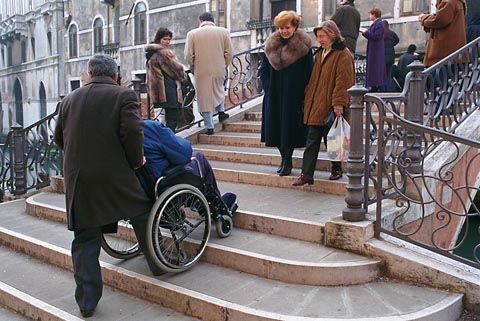  Venice is not without its problems
CongestionThose accustomed to suburban living may find the proposed densities too high, and it is certainly true that not everyone wants to live in a dense urban core. Historically, the densities I propose are not unusual, and the low suburban densities now common have only developed since the automobile initiated the process of urban sprawl. The perceived congestion of modern cities is largely a consequence of trucks and cars. On a sunny afternoon, Venice probably has the highest population density of any city in the world, yet it does not feel oppressively crowded. When streets are dedicated to human uses, the perception of congestion is considerably reduced.
Some families with children prefer to live in the suburbs because of some of the disadvantages of city life. However, many of these disadvantages disappear once the danger, congestion, noise, and pollution of the automobile have been removed. In addition, the presence of large, nearby open space provides an outdoor environment superior in many ways to the suburbs. Finally, the removal of the automobile makes cities safe for children. NoiseThe invention of electronically amplified music has severely taxed the ability of people to live in close proximity to one another. It seems difficult to manage this problem, although a strong sense of community would certainly help. Much more work needs to be done regarding adequate acoustical isolation of dwellings. Independent side bearing walls help to prevent building-to-building transmission, raising construction costs slightly. Floor-to-floor transmission is a more difficult problem but probably can be solved. Dutch police have authority simply to seize the offending equipment after repeated offenses.Mixed UsesMany planners still hold to the doctrine of the separation of uses. While the reference design for carfree cities could be modified to permit separation of uses, I am quite certain that a city with integrated uses will be a better place to live. It is, of course, possible to try both approaches. In the case of mixed uses, safeguards are required to protect residents from noxious uses.Shipping in ContainersFor a variety of reasons, much freight is not yet moved in standard shipping containers. The growth in containerized shipping will probably continue. Those shipping into and out of a city using metro freight would be forced to use shipping containers for everything larger than the largest, heaviest parcel that a reasonably fit individual can handle alone. Parcels would be consolidated and shipped together in one container.The Love of CarsAmericans are generally regarded as being in the throes of a love affair with their cars and will not give them up for anything. In fact, there seems to be a growing realization of the costs of cars, and people are losing their patience with traffic jams. The burgeoning popularity of the New Urbanism signifies that Americans realize that something was lost when the automobile came to dominate the urban landscape and that it is time to try something else. Paradoxically, the New Urbanism is largely a return to urban patterns which were common before the automobile's arrival. I think the love affair is coming to an end. Divorce proceedings loom on the horizon. (Katie Alvord recently published Divorce Your Car, for those who have irreconcilable differences with their cars.)The rest of the world was never so crazy about cars as the US. Europeans own nearly as many cars as Americans but make less use of them. No European city is without public transport which functions relatively well. Many European cities now have a carfree area at the heart of the city, and many of these have been expanded in recent years. The EU is about to begin a far-reaching action to limit the environmental damage by cars, including noise.
If the developed nations set a better example by abandoning their own cars, it is possible that the rest of the world will stop regarding car ownership the badge of prosperity and modernity. I had much more to say about all of this in the book. When I have a moment, I'll revise and extend this page. |
Continue on to Compromises
Return Home
About the book: Carfree Cities
E-mail
carfree.com
Copyright ©1996-2002 J.Crawford